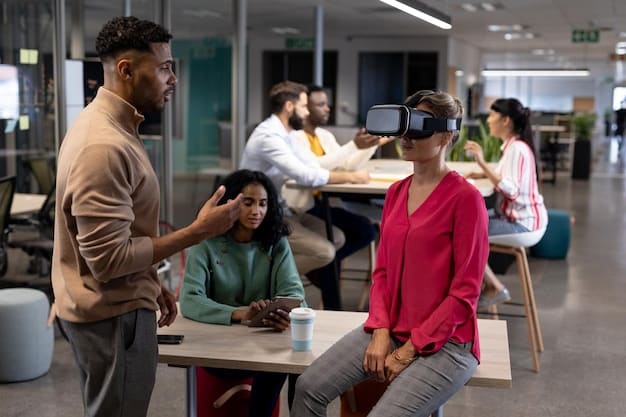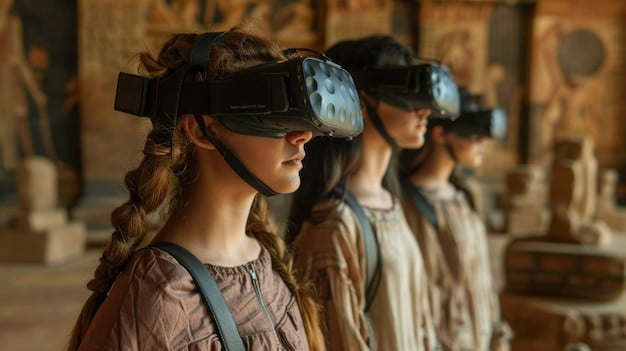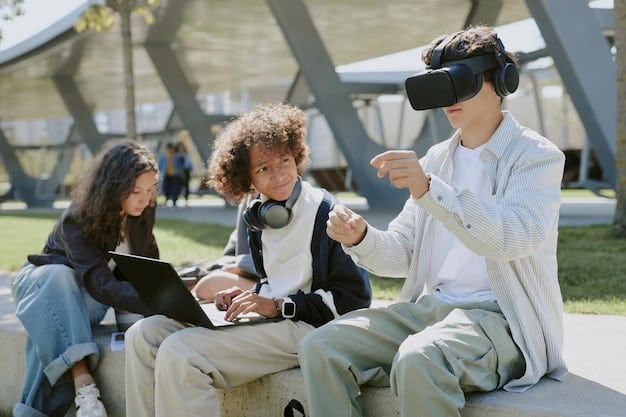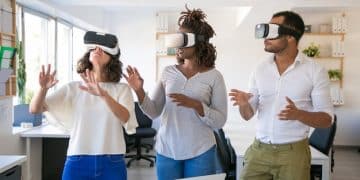Virtual Reality in US Schools: Enhancing Learning Outcomes

Virtual reality (VR) is increasingly used in US schools to enhance student learning outcomes by providing immersive, interactive, and engaging educational experiences that cater to diverse learning styles and offer access to virtual field trips, simulations, and collaborative projects.
Are you curious about how virtual reality is transforming education in the United States? How are US schools using virtual reality to enhance student learning outcomes? The answers might surprise you.
Virtual reality: A new frontier in education
Virtual reality (VR) is no longer just a futuristic concept or a tool for entertainment. It’s rapidly becoming an integral part of the educational landscape in the US. Schools across the nation are exploring innovative ways to incorporate VR technology into their curricula to enhance student learning outcomes.
The immersive nature of VR creates opportunities for students to engage with educational content in a way that traditional methods simply can’t match. By transporting students to different time periods, far-off locations, or even inside the human body, VR is making learning more engaging, accessible, and effective.
The benefits of VR in education
VR offers a multitude of benefits to students and educators alike. From increased engagement and improved comprehension to enhanced collaboration and personalized learning, the potential of VR in education is vast. Here are some key advantages:
- Increased Engagement: VR captivates students’ attention and makes learning more exciting and interactive.
- Improved Comprehension: Immersive experiences help students visualize and understand complex concepts.
- Enhanced Collaboration: VR enables students to collaborate on projects and simulations in virtual environments.
- Personalized Learning: VR allows educators to tailor learning experiences to meet individual student needs.

VR technology also provides access to learning experiences that may otherwise be inaccessible. For example, students can take virtual field trips to museums, historical sites, or even outer space without ever leaving the classroom. This can be particularly beneficial for students from low-income communities or those with disabilities.
In conclusion, virtual reality is not just a technological innovation; it is a powerful tool that has the potential to transform education in remarkable ways.
Applications of VR in US schools
Across the US, schools are finding creative and effective ways to incorporate VR into their classrooms. These applications span a wide range of subjects and grade levels, demonstrating the versatility of VR as an educational tool.
From science and history to language arts and mathematics, VR is being used to bring lessons to life and make learning more relevant and engaging for students. Let’s explore some specific examples of how VR is being used in US schools:
Science education
VR is revolutionizing science education by allowing students to conduct virtual experiments, explore the human body, and even travel to distant planets.
For example, students can dissect a virtual frog without the mess or ethical concerns associated with traditional dissection. They can also explore the inner workings of the human heart or witness the eruption of a volcano from a safe distance. These immersive experiences can help students develop a deeper understanding of scientific concepts and foster a lifelong love of learning.
History and social studies
VR is also transforming the way history and social studies are taught. By transporting students to different time periods and locations, VR is making history come alive.
- Students can walk through the streets of ancient Rome, witness the signing of the Declaration of Independence, or explore the Amazon rainforest.
- These immersive experiences can help students develop a greater appreciation for different cultures and historical events.
- VR can also be used to promote empathy and understanding by allowing students to experience historical events from different perspectives.
In summary, VR is proving to be a valuable tool in enriching the learning experience in science, history, and social studies, making these subjects more engaging and memorable for students.
The impact of VR on student engagement and motivation
One of the most significant benefits of VR in education is its ability to increase student engagement and motivation. Traditional teaching methods can often be passive and disengaging, leaving students feeling bored and disconnected from the material.
However, VR offers a more active and immersive learning experience that can captivate students’ attention and make learning more enjoyable. Let’s examine how VR is boosting student engagement and motivation:
Enhancing engagement through immersion
The immersive nature of VR creates a sense of presence that can draw students into the learning experience. When students feel like they are truly “there,” they are more likely to be engaged and motivated to learn.
VR environments can simulate real-world situations, allowing students to practice skills and apply their knowledge in a safe and supportive environment. This can be particularly beneficial for students who struggle with traditional classroom settings or who learn best through hands-on activities.
Boosting motivation through relevance
VR can also make learning more relevant to students’ lives by connecting classroom concepts to real-world applications.
- For example, students learning about architecture can use VR to design and build virtual structures.
- Students studying environmental science can explore the impact of pollution on a virtual ecosystem.
- By seeing the relevance of what they are learning, students are more likely to be motivated to succeed.

In conclusion, virtual reality offers a powerful way to increase student engagement and motivation by creating immersive and relevant learning experiences.
Challenges and considerations for implementing VR in schools
While VR offers a wealth of potential benefits for education, there are also several challenges and considerations that schools must address before implementing VR programs. These challenges range from cost and technology infrastructure to teacher training and content development.
Let’s take a closer look at some of the key challenges and considerations for implementing VR in schools:
Cost and accessibility
One of the biggest barriers to VR adoption in schools is the cost of the technology. VR headsets, computers, and software can be expensive, especially for schools with limited budgets.
However, the cost of VR technology is decreasing over time, making it more accessible to schools. Additionally, some schools are finding creative ways to fund VR programs through grants, donations, and partnerships with local businesses.
Teacher training and support
Another important consideration is teacher training and support. Teachers need to be trained on how to effectively integrate VR into their lessons and how to troubleshoot technical issues.
- Schools also need to provide ongoing support to teachers to help them stay up-to-date on the latest VR technologies and best practices.
- Some schools are creating dedicated VR labs or centers to provide teachers with the resources and support they need.
- Professional development workshops and online training courses can also help teachers develop the skills and knowledge they need to use VR effectively.
In summary, while implementing VR in schools presents certain challenges, proactive planning and investment in resources like teacher training can pave the way for successful integration.
Examples of successful VR programs in US schools
Despite the challenges, many US schools have successfully implemented VR programs that are having a positive impact on student learning outcomes. These programs offer valuable insights and lessons learned for other schools looking to adopt VR technology.
Let’s explore some specific examples of successful VR programs in US schools:
Case study: A rural high school using VR for college readiness
A rural high school in the Midwest is using VR to help students prepare for college.
The school has created a virtual campus tour that allows students to explore different colleges and universities without having to travel long distances. Students can also use VR to practice job interview skills and participate in virtual career fairs. This program has helped to increase the number of students who go on to attend college.
Case study: An urban elementary school using VR for special education
An urban elementary school in the Northeast is using VR to support students with special needs.
- The school has created a virtual calm room where students can go to relax and de-stress.
- Students with autism can use VR to practice social skills in a safe and controlled environment.
- The school has also used VR to create virtual field trips that are accessible to students with mobility impairments.
These case studies demonstrate that with thoughtful planning and implementation, VR can be a powerful tool for enhancing student learning outcomes in a variety of educational settings.
To conclude, the success stories of VR integration in various US schools highlight the immense potential of this technology to transform education and improve student experiences.
The future of VR in education
The use of VR in education is still in its early stages, but the technology is rapidly evolving and becoming more sophisticated. As VR technology continues to improve, it is likely to play an even greater role in education in the years to come.
Here are some potential future developments for VR in education:
Personalized learning experiences
VR has the potential to create highly personalized learning experiences that are tailored to individual student needs. Adaptive VR programs can adjust the difficulty level based on student performance, providing targeted support and challenge.
VR can also be used to create simulations that allow students to explore different career paths and make informed decisions about their future. These simulations can provide students with valuable real-world experience and help them develop the skills and knowledge they need to succeed.
Collaborative learning environments
VR can also facilitate collaborative learning by connecting students from different schools, states, or even countries. Students can work together on virtual projects, share ideas, and learn from each other’s experiences.
- This can help to broaden students’ perspectives and prepare them for a globalized world.
- VR can also be used to promote cross-cultural understanding and empathy.
- By connecting students from different backgrounds, VR can help to break down barriers and build bridges.
In conclusion, the future of VR in education is bright, with endless possibilities for enhancing learning outcomes and creating more engaging and effective educational experiences.
| Key Point | Brief Description |
|---|---|
| 🚀 Immersive Learning | VR offers experiences not possible with traditional methods. |
| 🌍 Virtual Field Trips | Students explore the world without leaving the classroom. |
| 🧑🏫 Teacher Training | Effective VR integration requires trained educators. |
| 💰 Cost | VR hardware and software costs can be a barrier. |
Frequently asked questions
▼
VR is a technology that creates immersive, interactive experiences for users. In education, VR uses headsets to simulate real-world environments, allowing students to explore and interact with 3D models.
▼
VR is most effective in subjects like science (virtual dissections), history (exploring historical sites), and geography (virtual field trips). It offers a hands-on approach to otherwise abstract concepts.
▼
VR improves engagement by providing immersive, interactive experiences that capture students’ attention. This active learning approach leads to better retention and a more enjoyable educational experience.
▼
The main challenges include the high initial cost of VR equipment, the need for adequate teacher training, and ensuring that VR content is both educational and age-appropriate for pupils.
▼
Schools can seek grants, partner with tech companies, and explore low-cost VR solutions like smartphone-based headsets. Sharing VR labs among districts can also distribute the cost of the technology.
Conclusion
In conclusion, the integration of virtual reality in US schools presents a transformative opportunity to enhance student learning outcomes. While challenges such as cost and teacher training exist, the potential benefits of increased engagement, improved comprehension, and access to immersive educational experiences are undeniable.





